Costa Rica (mainly batting and ratting)
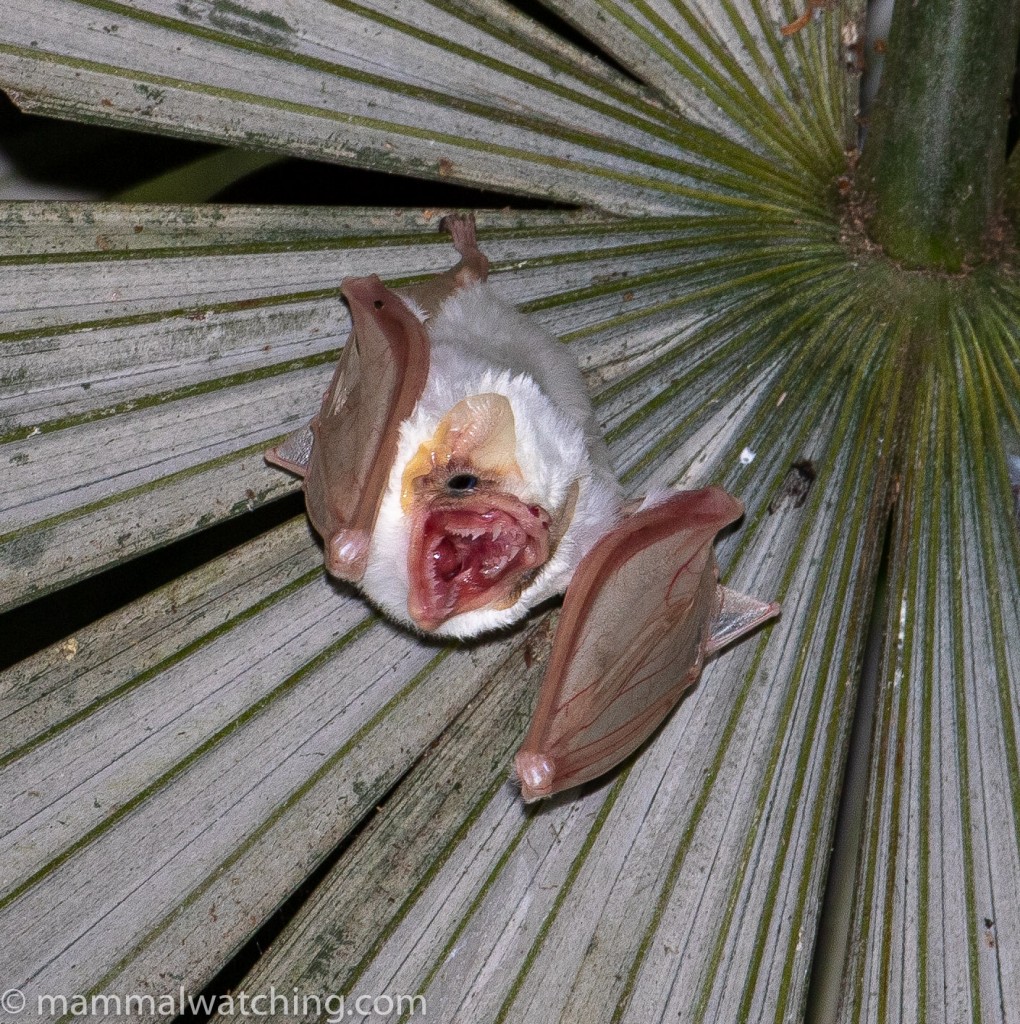
Northern Ghost Bat, Diclidurus albus. Carara National Park.
I visited Costa Rica in January 2021, travelling with Fiona Reid for a few days in the mountains before going to her place(s) near Golfito. She had planned a bat blitz there in March 2020, but that was COVID-cancelled so this was a chance to find some of the species I had been looking forward to last year.
Our itinerary was based around seeing a few mammals that we both wanted to see – Thumbless Bat, Dice’s Cottontail and Bang’s Montane Squirrel – as well as a few that I had not seen including Wrinkle-faced Bat, Alfaro’s Pygmy Squirrel and Watson’s Climbing Rat.
The good news is that – if you can get there – Costa Rica is open and pretty much running at full speed despite COVID19. Travelling from the US you do not need a COVID test to enter the country, though you must have health insurance covering the cost of COVID treatment and quarantine should you fall ill. The government has authorised two companies to provide this and it costs around $10 a day.
The better news is if you can visit there are very, very few tourists around. So there seems no need at all to book much in advance or worry about dealing with noisy H. sapiens in many places which are usually busy.
The USA introduced compulsory COVID testing for those flying to the States the week I was away, and many clinics were springing up around Costa Rica offering 48 hour testing. There was still a little confusion about where to get a test last month, but the system is now working fine from what I can tell.
I rented a car from Alamo near the airport. Car hire is a lottery in Costa Rica and the prices quoted on Expedia are often wildly different from the final bill. I checked in advance with Alamo about the real cost. They were very helpful, confirming the bottom line I would have to pay including various compulsory insurance and tax charges.
Selva Verde Lodge, Sarapiqui
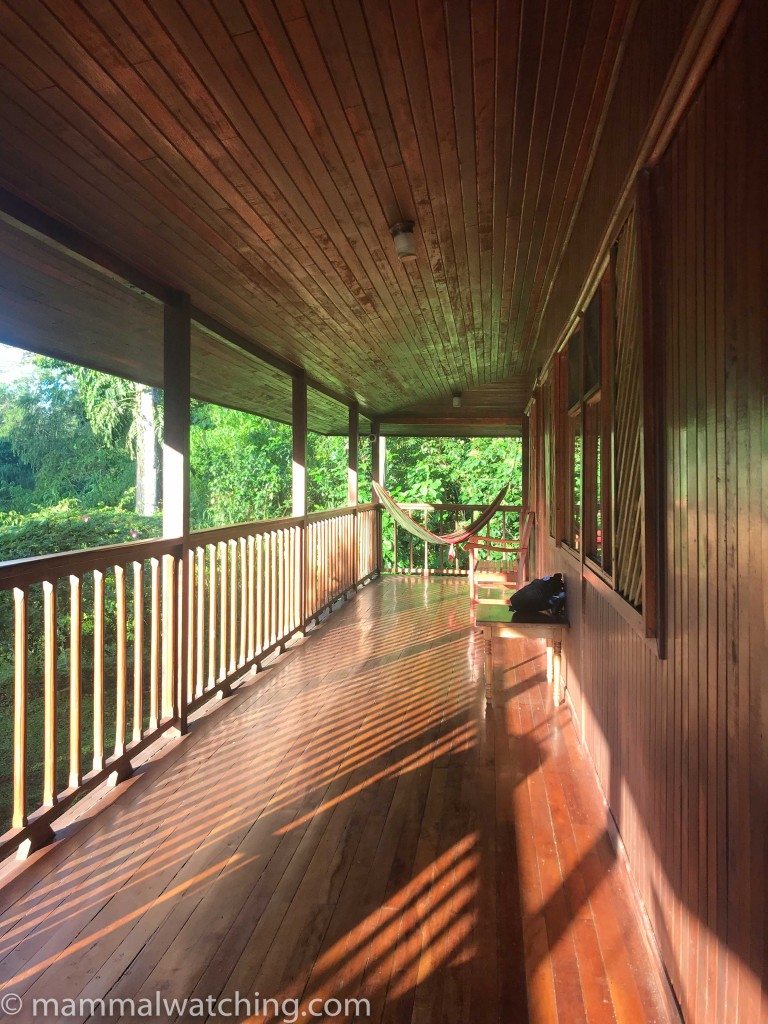
Selva Verde Lodge
Selva Verde is a large and quite expensive ecolodge, almost next door to the Tirimbina Reserve, a couple of hours due north of San Jose airport. There may have been one other room occupied when we were there.
It is a pleasant hotel, though less pleasant if you are staying in one of the rooms near the busy main road. And it seems you have to pay for a guide before you can walk any of the trails. So there is probably not much here to attract a serious mammalwatcher compared to somewhere like Tirimbina next door. Selva Verde’s main draw is a colony of Thumbless Bats roosting under one of the bungalows. This is an apparently rare bat, that is seldom caught. It is also a member of one of the last 18 mammal families I haven’t seen.
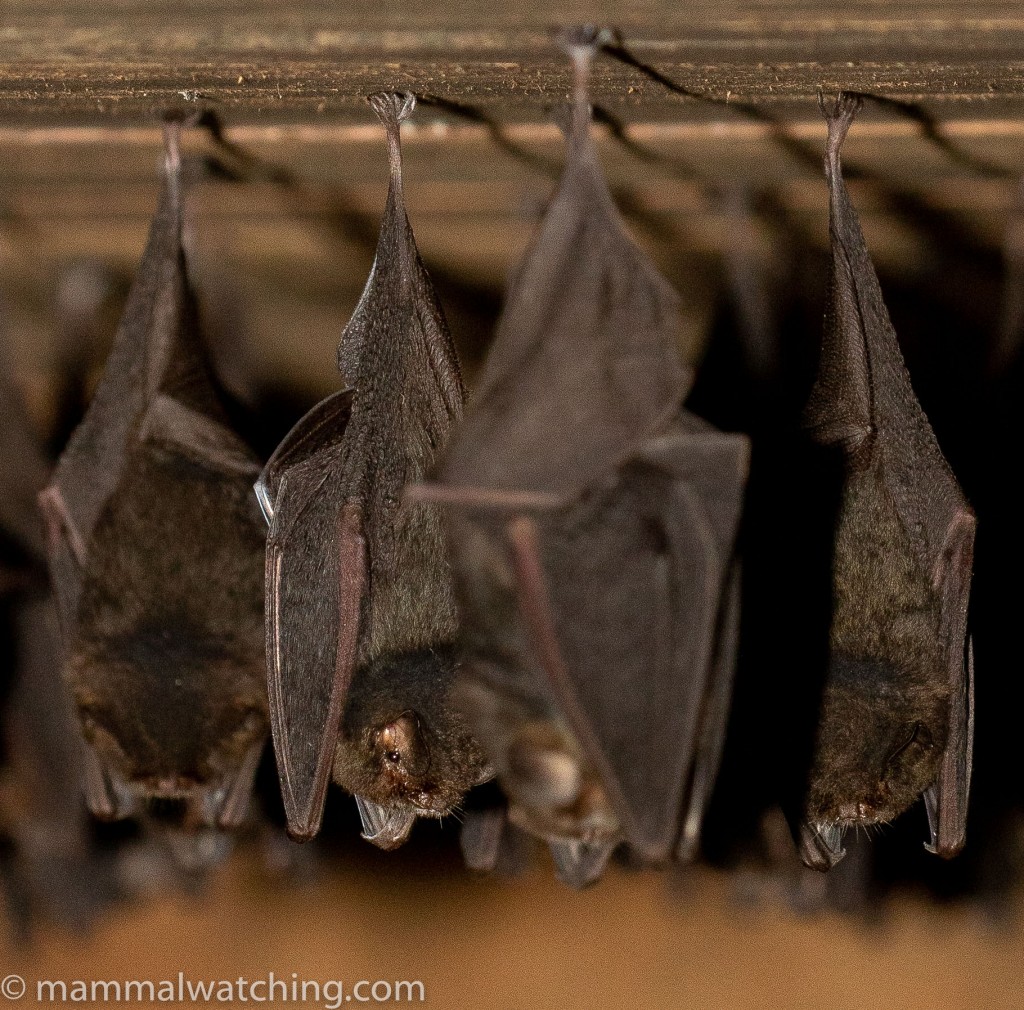
Thumbless Bats, Furipturus horrens.
The lodge are proud of their bats, and the discovery of the colony by handyman Henry Lara in 2017 was only the second record for Costa Rica, and the first since 1973. The staff at the hotel were very helpful in keeping me informed over the course of the year about the colony (I was hoping to visit in March 2020), and I was happy to hear the colony grew to 80 animals (quite probably because COVID meant less disturbance). They arranged for Henry – who first discovered the bats – to show us the roost.
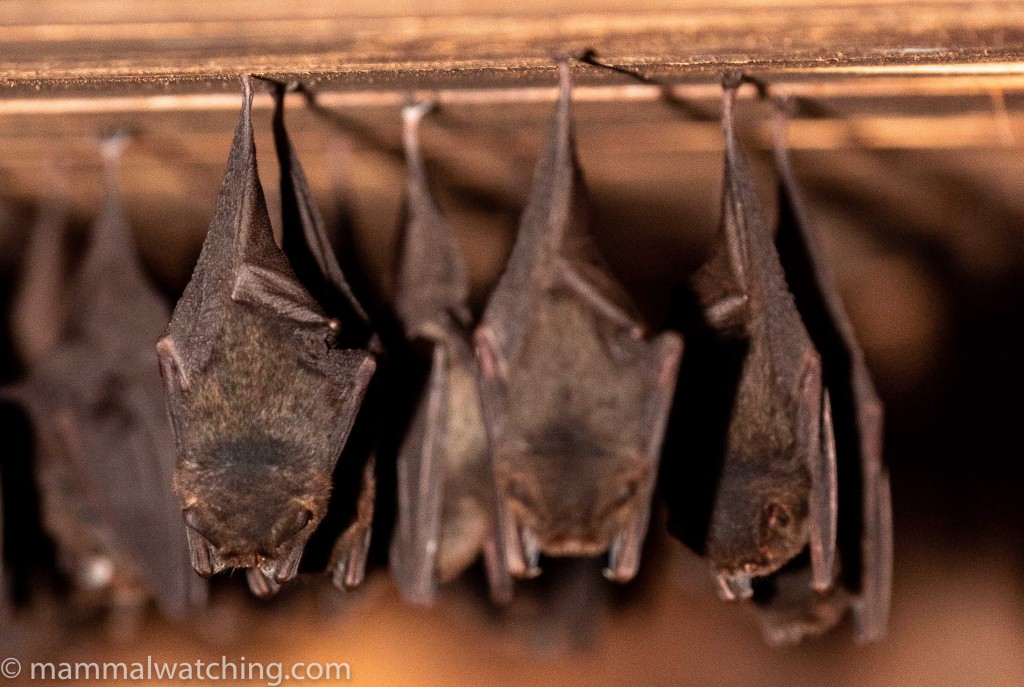
Thumbless Bats, Furipturus horrens.
Henry is understandably proud of his discovery: not only did he spot the bats but he took the time to photograph them and have them identified. And, although he does not work at the hotel, he still monitors the colony and obviously cares about the animals. The bats are tucked away and hard to get a good look at. Direct flash photography is discouraged.
Henry also showed us a small group of Common Big-eared Bats roosting right next to the Thumbless Bats. Photographing them was even more difficult.
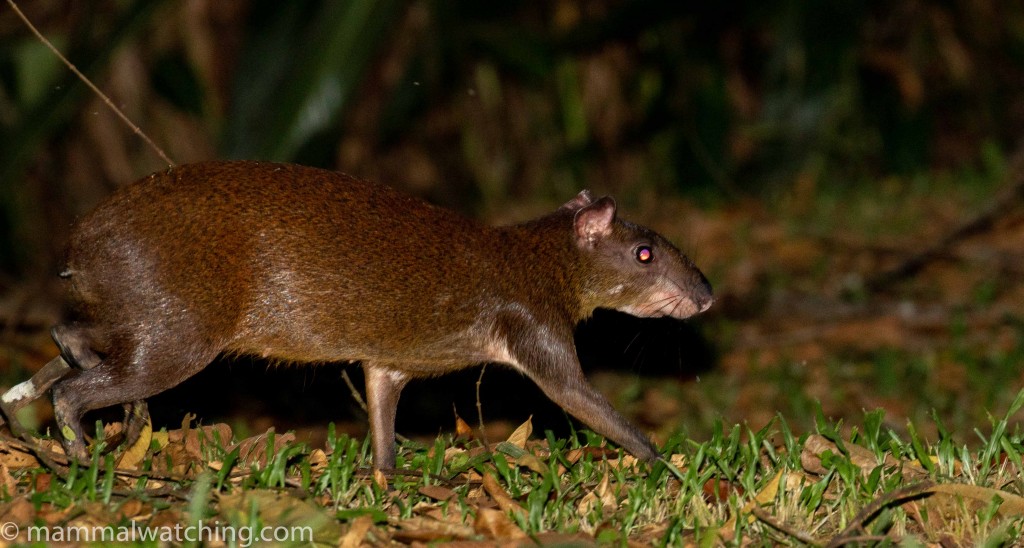
Central American Agouti, Dasyprocta punctata
Other than the bats, we saw several Central American Agoutis, Proboscis and Greater White-lined Bats and Variegated Squirrels in the hotel or the gardens.
Poas Volcano
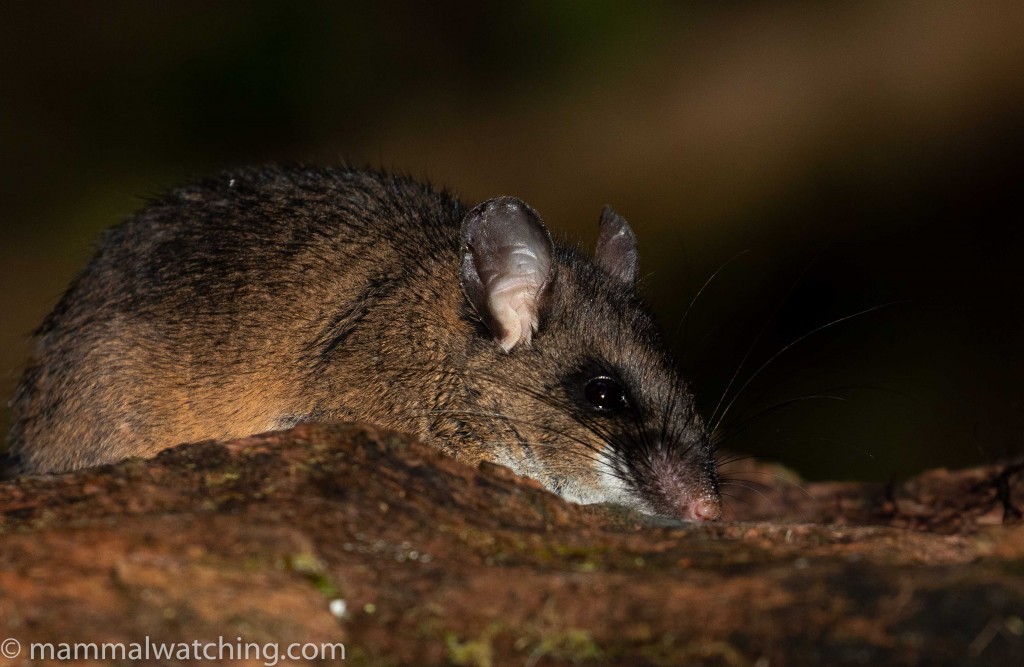
Nicaraguan Deermouse, Peromyscus nicaraguae
Our next target was Bang’s (or Poas) Montane Squirrel. This is a little known, and very often mis-identified squirrel, that is seldom reported. Many of the pictures online are incorrect including on wikipedia (often these pictures are in fact Red-tailed Squirrels). Montane Squirrels look very different, with tiny ears and a different face as this photo from Gregory Willis shows.
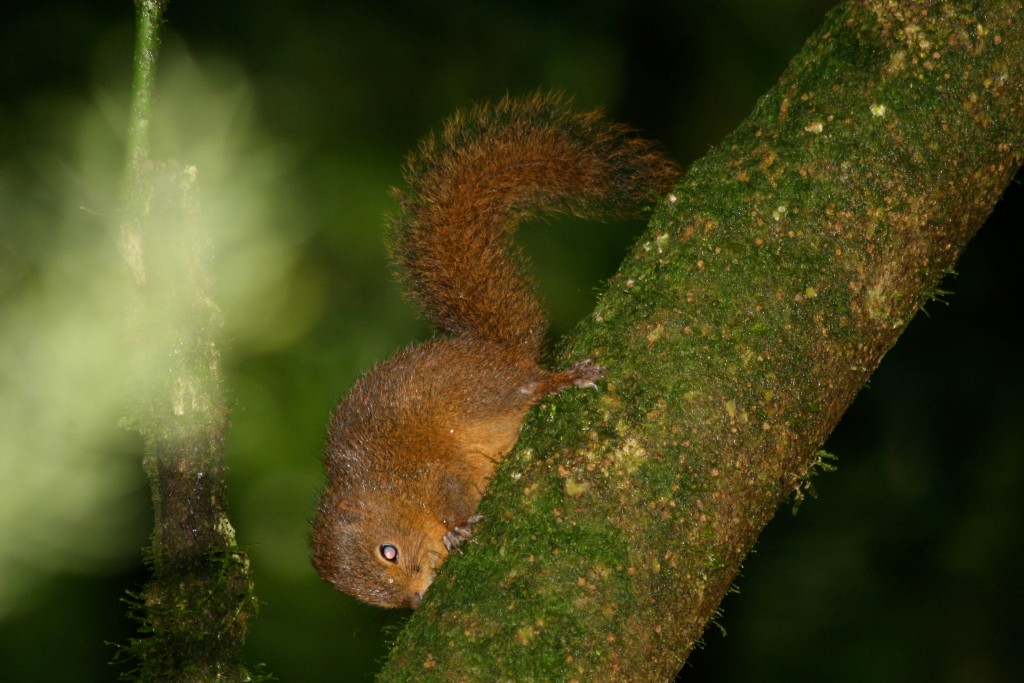
Bangs’s mountain squirrel (Syntheosciurus brochus). Photo Gregory E Willis.
The only paper I could find with information from Costa Rica was this one, by Jackie Willis, as she is now called, from the late 1980s where she studied squirrels on Poas.
Jackie has not been back to Poas for many years but she was extremely helpful when I got in touch to ask her advice. There is a lot of information in her paper but, in short, the squirrels were fairly common in the park and were the most frequently encountered squirrel there. They were active throughout the day, especially fairly early in the morning and late afternoon, and do not vocalize very much. She gave us tips on areas of the park where they used to be quite common but warned that much in the park has changed since the late 80s.
When I was in Poas in 2010 I saw a lot of people and several Red-tailed Squirrels along the trail to the crater but no Montane Squirrels and no great habitat (they seem to like bamboo, epiphytes and Clusia trees amongst others). Things have gotten even more difficult since then. We spent a day looking but had no success. We didn’t even see a Red-tailed Squirrel.
First, never go to Poas on a Sunday. Despite COVID19 the road to the park entrance – which is through decent looking forest – was extremely busy with a stream of traffic and picnicking people. We walked along it for three hours but saw no mammals at all.
Second, to enter the park nowadays you need to buy a ticket online in advance and, once you enter, can only walk along one trail to the crater. Worse, when you get to the crater you can stay a maximum of 20 minutes to look around before having to leave. We didn’t even bother going in.
In part these draconian rules are a result of COVID19 and staff shortages but neither of us were in a hurry to stay longer there.
At the end of my trip I met up with Carlos Roberto Chavarria (see the Carara section below). Carlos, who is from the Poas area, said the squirrels are still there and quite common but you need to access the right trails. And that requires having contacts in the National Park. So, if I do return, I would talk to Carlos first.
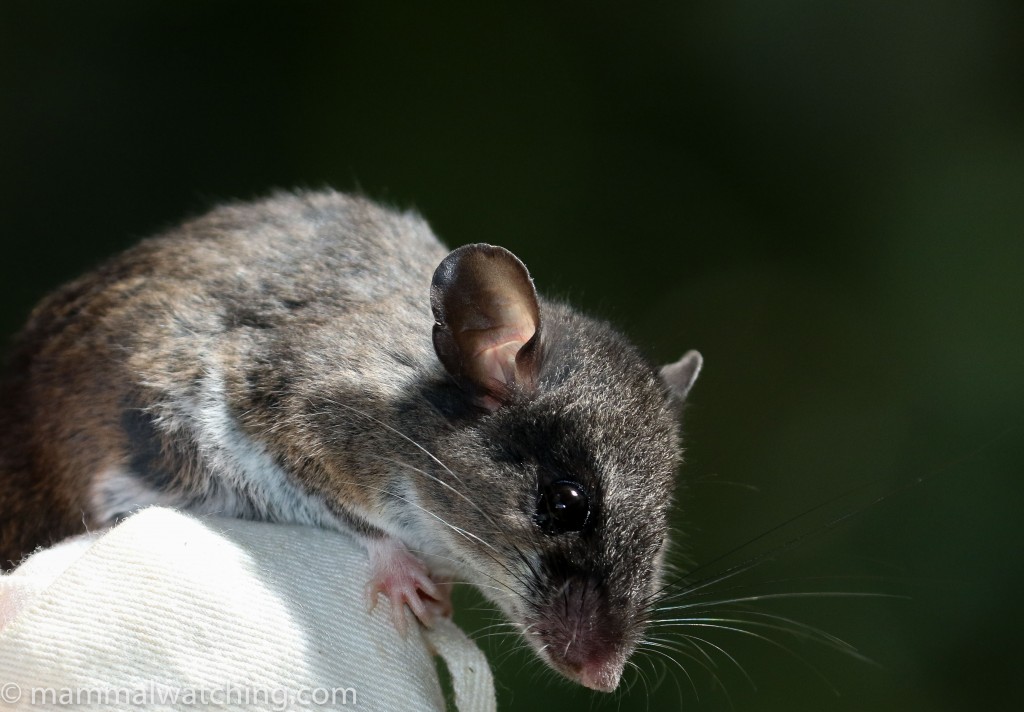
Nicaraguan Deermouse, Peromyscus nicaraguae
Outside the park we set a few traps in the hotel garden and Fiona caught some Nicaraguan Deermice. Not the Montane Squirrel I was hoping for but still an attractive rodent.
Las Vueltas Lodge
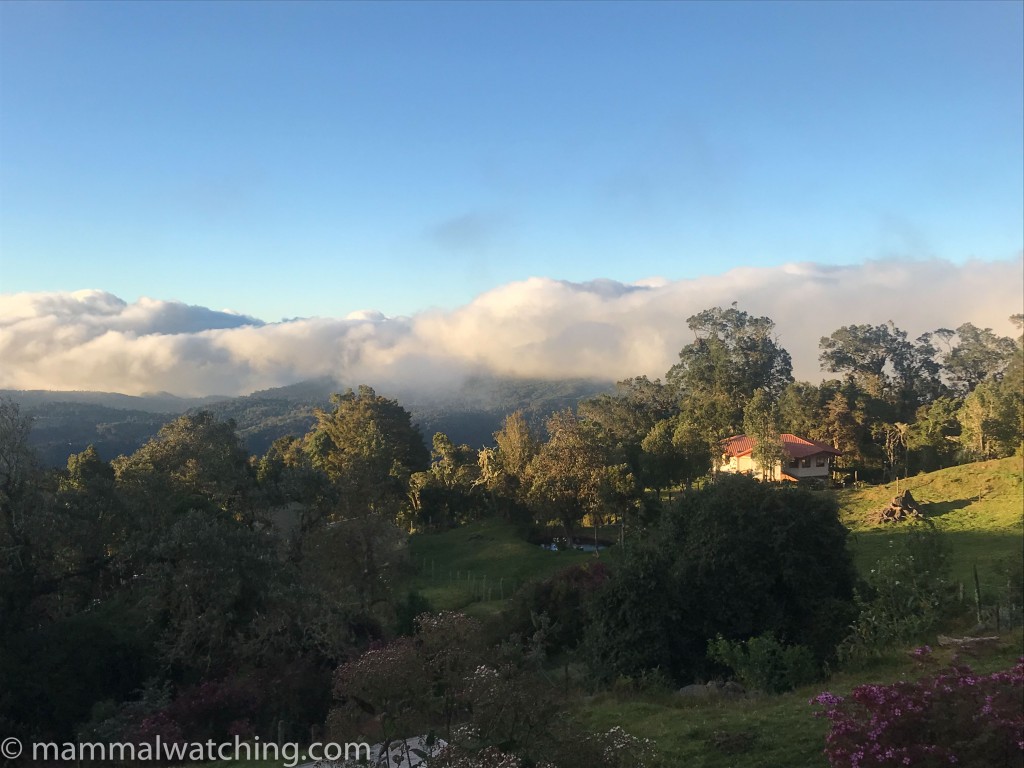
Our next stop was Las Vueltas ecolodge, a place we stumbled on after researching Montane Squirrel sightings on iNaturalist. Fiona found a record of what looked very like Syntheosciurus from the lodge itself and another from the entrance to Los Quetzales National Park a few kilometres along the highway.
Las Vueltas is everything Poas is not: blissfully quiet and without any restrictions. Moreover, the owners – the Seelye family – are super helpful about the farm’s wildlife. The rooms were just the right amount of comfortable and the food was fantastic. A great spot and somewhere I plan to return to. We loved it.
The lodge is up at around 3000 metres. Over the years the Seelyes have seen some very cool, rare mammals on the farm including Grisons and Underwood’s Water Mice (which of course we tried hard to catch).
Our main focus though were Montane Squirrels and Dice’s Cottontail and any of the many rodents I hadn’t seen from the cloud forest including the Chiriqui Pocket Gophers that were digging up the path to the farm’s beehive.
And as I understand a few people are interested in bird then yes, we had no trouble seeing Quetzals, and even I saw one without trying. This Unspotted Saw-whet Owl is apparently a decent species too.
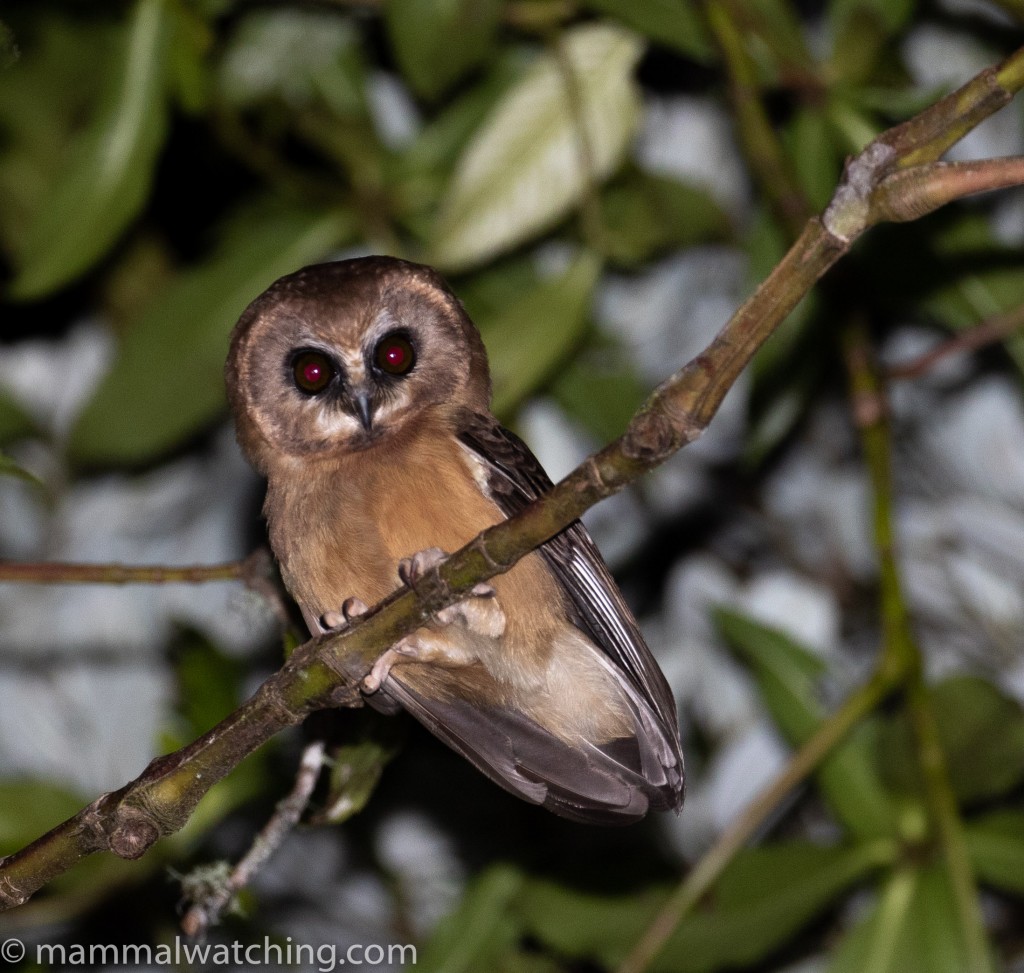
Unspotted Saw-whet Owl
Back to the mammals.
Dice’s Cottontail are a high altitude species that are declining in many areas because of Coyote predation. The area around Las Vueltas is still good for them though. The Seelyes often seem them after dark at one spot along the road into the farm. And the first few kms of the road down to Providencia from Los Quetzales were also reputed to be good.
We spent a couple of hours driving the rough and very steep road to Providencia after dark. Even in a 4WD with low ratio and a bone dry road it was a challenge getting back up some of the steep sections. We also got a flat tyre. A few kilometres down the road we heard what was probably a Cacomistle calling and, closer to Providencia, a rodent ran across the road which – on the basis of size and its strongly demarcated black body and white belly – must have been a Mountain Spiny Pocket Mouse (Heteromys oresterus). The nearly full moon probably wasn’t helping us see stuff. We had almost returned to the main road when a rabbit here bolted in front of the car here at about 10pm. It looked a bit darker than a Gabb’s Cottontail, but, in any case, Dice’s Cottontail should be the only rabbit here.
Montane Squirrels are also here. On the first morning, at around 7.30, a squirrel ran in front of us in the forest near the farm fishpond. It looked quite small and the tail was far less fluffy than a Red-tailed Squirrel’s (particularly those up this high). But I didn’t see the head well enough to get a good look at the ears and face shape. Meanwhile Fiona, who’s opinion I trust much more than mine, said it was definitely not red-tailed, because the tail ended in a point rather than being rounded. So that was good enough for me to know it was a Montane Squirrel. But it remains a species I want to see again. We kept looking of course but didn’t see any other squirrels at Las Vueltas over the course of 2 days.
We also walked the first kilometer of the road to Providencia through Los Quetzales National Park where Montane Squirrels also occur. Two Red-tailed Squirrels were a temporary source of excitement. But that was all we saw.
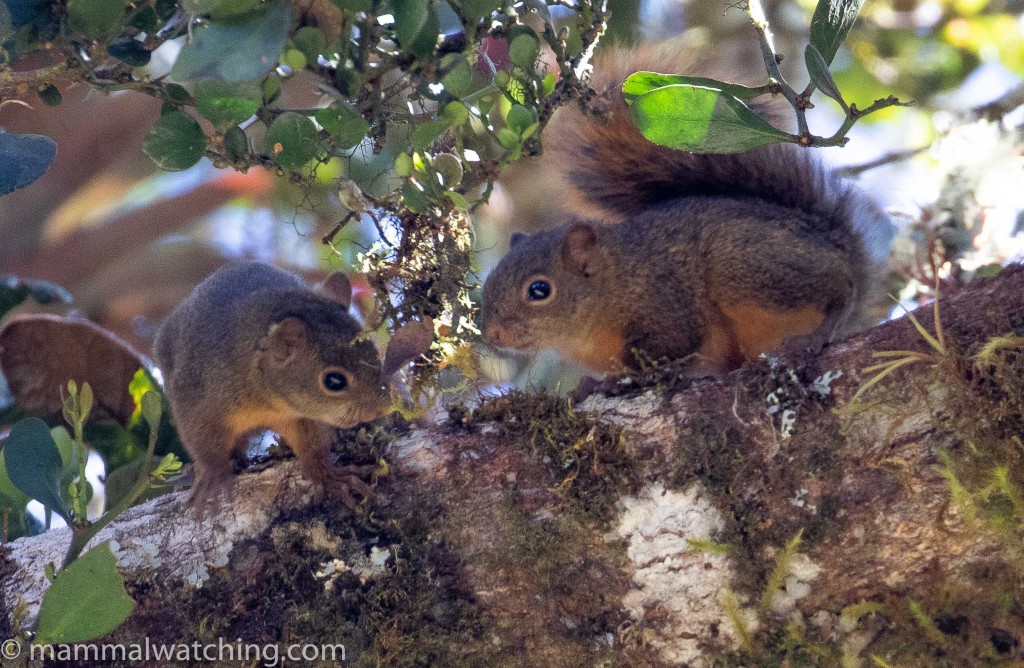
Red-tailed Squirrels, Sciurus granatensis
The Seelyes were happy for us to live trap rodents in the forest. We focussed on two small streams where they had seen the wonderful Underwood’s Water Mice once or twice over the years. A species I would love to see but a hard one to capture.
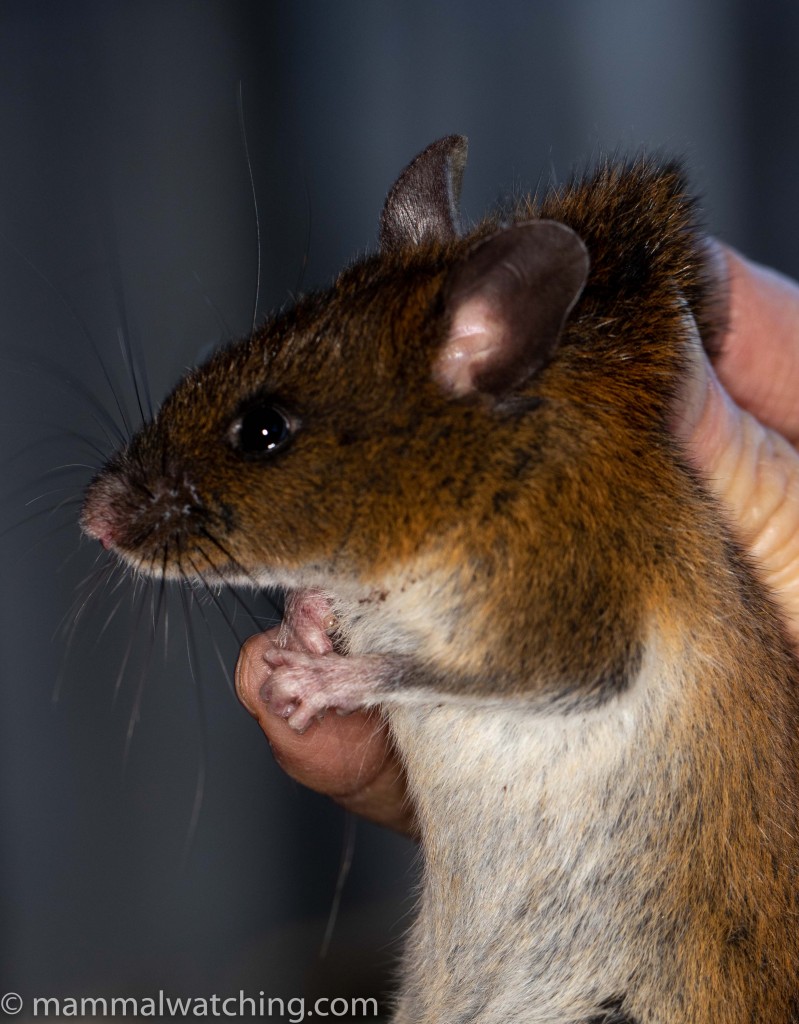
Boquete Rice Rat, Nephelomys devius
We didn’t find one. But we did catch several Talamancan Deermice, a Boquete Rice Rat and the uncommon Chiriqui Harvest Mouse (Fiona had only ever seen one before). This is the biggest harvest mouse species.
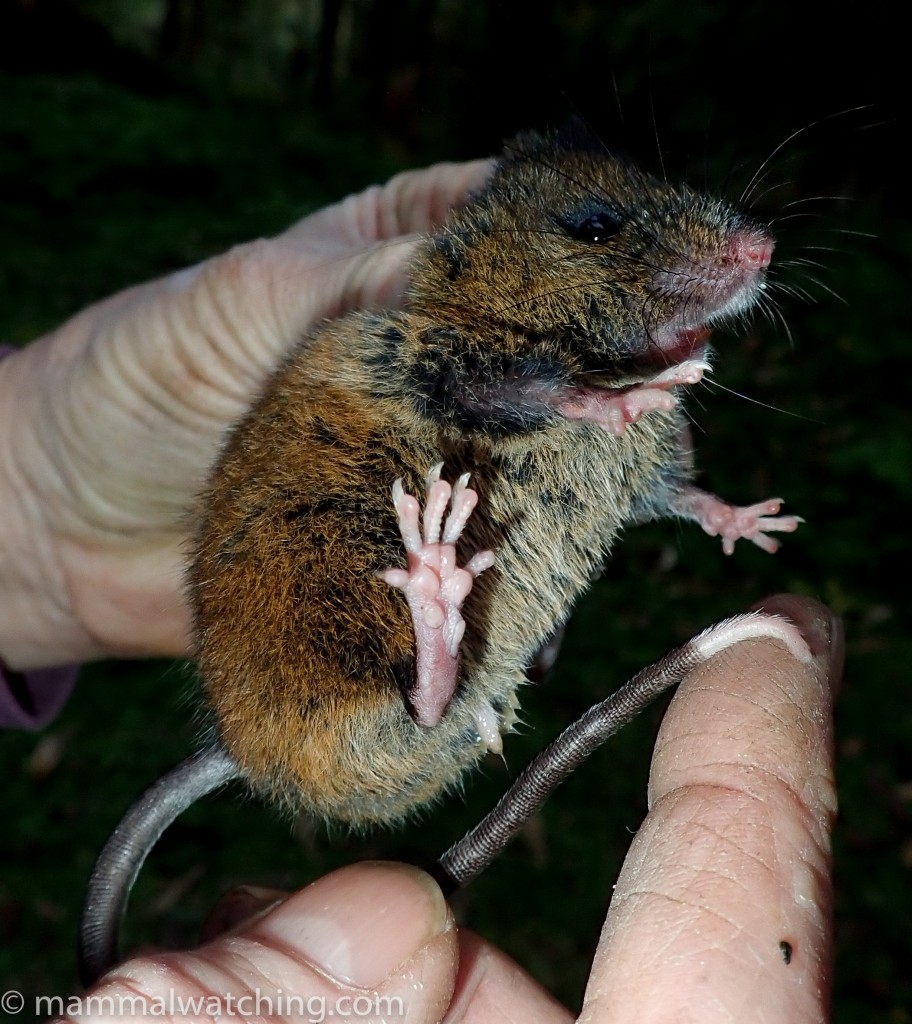
Chiriqui Harvest Mouse, Reithrontodontomys creper. They do not always have a white tail tip.
There are plenty of other small mammals here I am sure and with more time we would have caught some more of them. The Seelyes cat was more efficient than we were. It caught a Chiriqui Singing Mouse and a Cryptotis shrew while we were there.
Chiriqui Pocket Gophers were active close to the lodge. But gophers in the Neotropics seem more difficult to summon on command than those in the US. I opened up a couple of burrows and staked out the holes but saw nothing. The next morning they were closed. Perhaps these gophers are more strictly nocturnal than those further north.
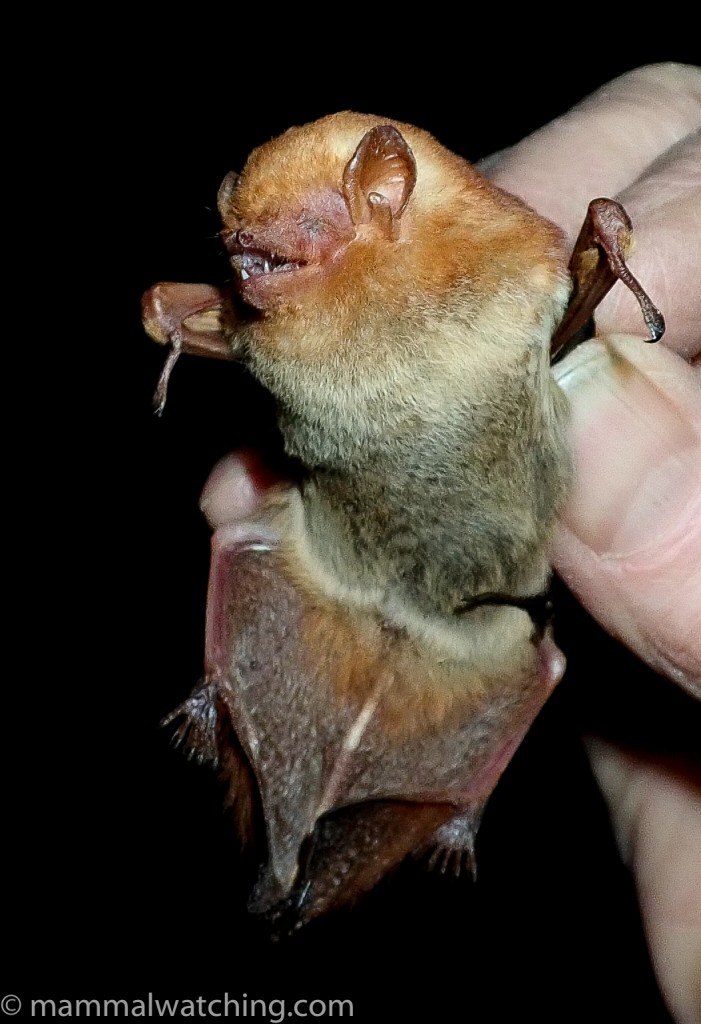
Desert Red Bat, Lasiurus frantzii
We spent one evening looking for water mice with a thermal scope. No mice, but Fiona spotted a Red Bat flitting around a stream, and it took about 3 minutes to catch it. A beautiful Desert (formally Western) Red Bat, a species I had seen in California but only in flight.
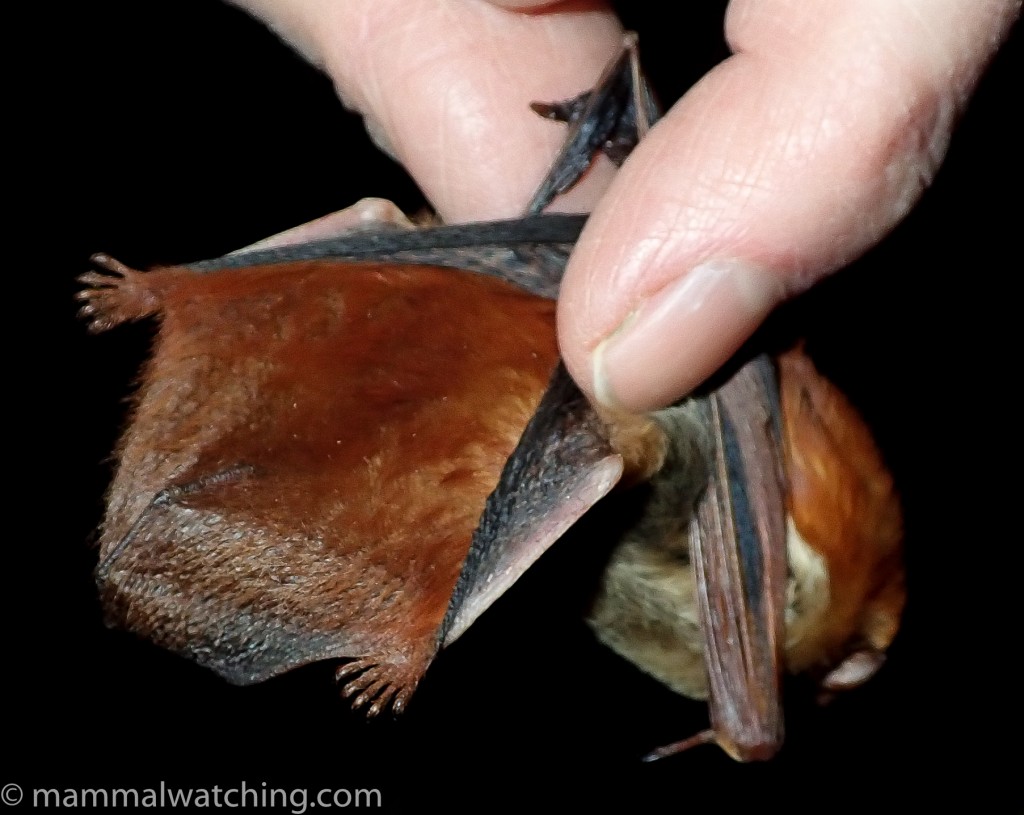
Desert Red Bat, Lasiurus frantzii
We left Las Vueltas determined to return and to stay longer.
Finca Bellavista Treehouses
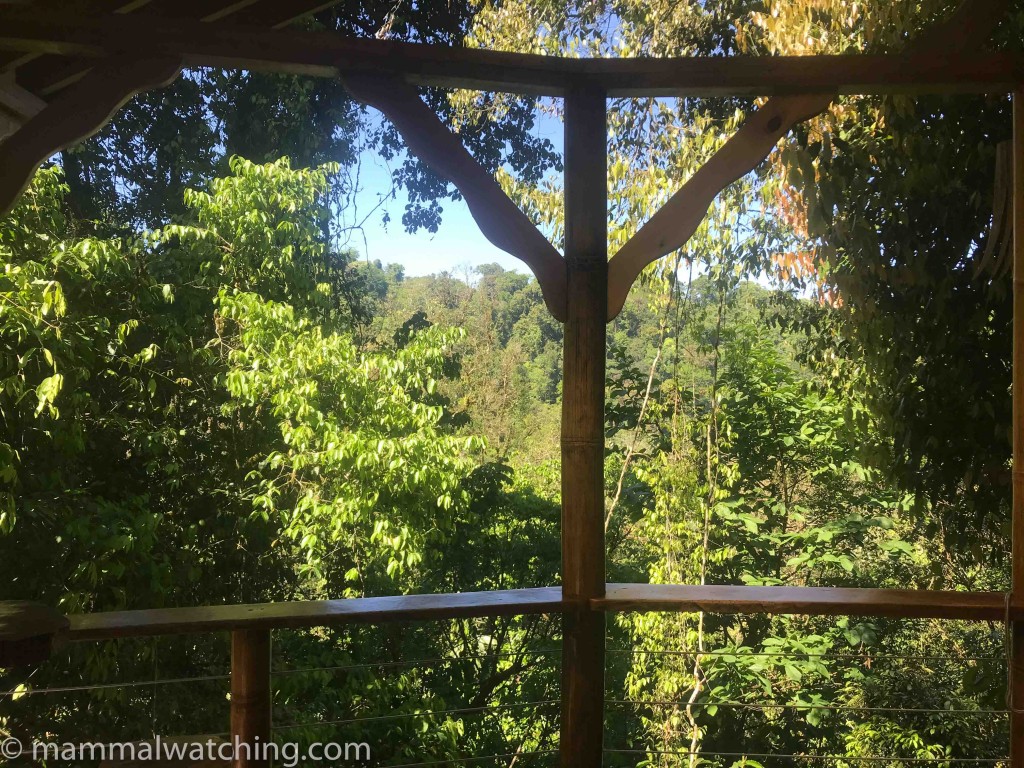
Spot the Pygmy Squirrel. The El Fenix balcony.
Heading south we stopped overnight at Fiona’s spectacular treehouse at the Finca Bellavista community. You can rent the house – El Fenix – through this site here. It is a beautiful place which I had visited in November 2019. I didn’t manage to catch any of the Watson’s Climbing Rats that are quite common in some treehouses. But I did see my key target: an Alfaro’s Pygmy Squirrel.
El Fenix’s balcony – at canopy level – is a perfect place to look for a pygmy squirrel and drink coffee, and we had good views of one at about 7 a.m.
This would be quite the place to relax for a couple of days and watch mammals in comfort. Coatis, Agoutis and Pacas are common in the forest here, while species including Greater White-lined Bats, Kinkajous, Woolly Opossums, Tomes’ Spiny Rats and Mexican Porcupines are often seen from the balcony.
Sylvan Falls
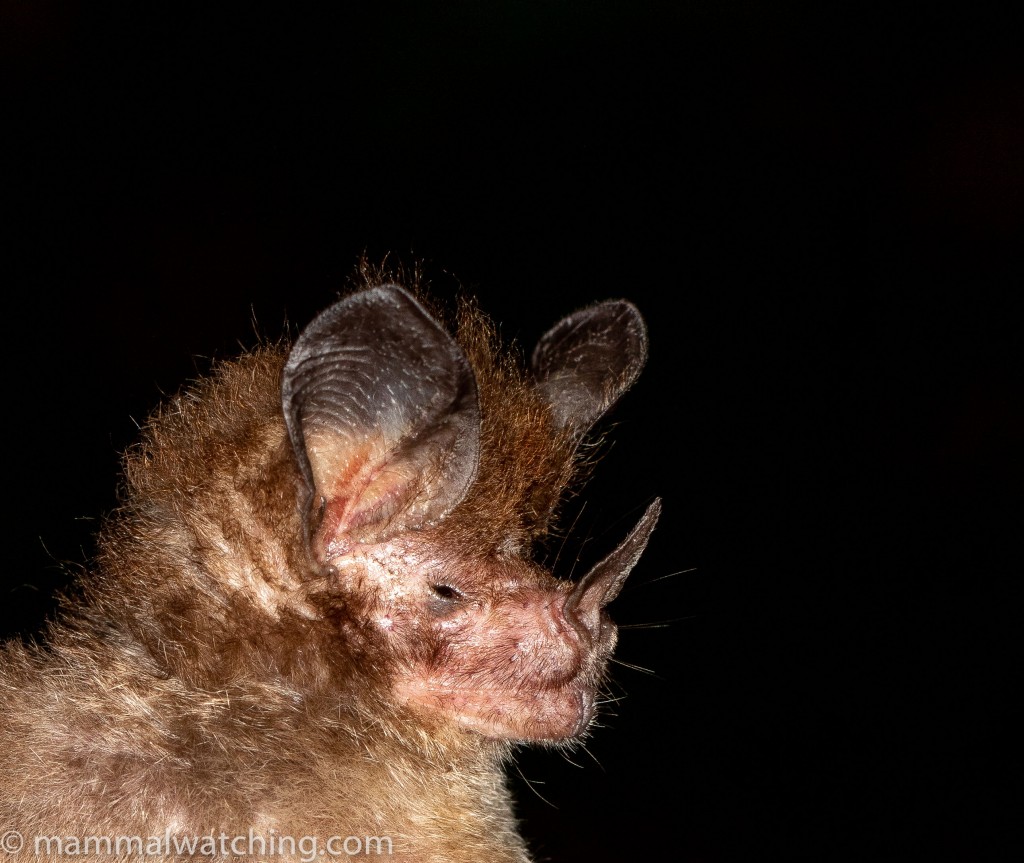
Hairy Big-eared Bat, Micronycteris hirsuta
My last destination was to Rio Claro and Fiona’s ecolodge Sylvan. I was here in November 2019 when she was getting started and I was glad to see the renovations had ensured the place lost none of its charm but gained a bit more comfort. The fridge was particularly welcome. So long, “stream temperature” beer.
I spent two nights here. Most of the day was spent trying to get a COVID test and see the resident Underwood’s Pocket Gophers which again outwitted me. Though this time I missed one by only 20 minutes. I opened the hole at dawn. Went to have a coffee and returned to find the hole closed. Next time I am bringing gopher traps.
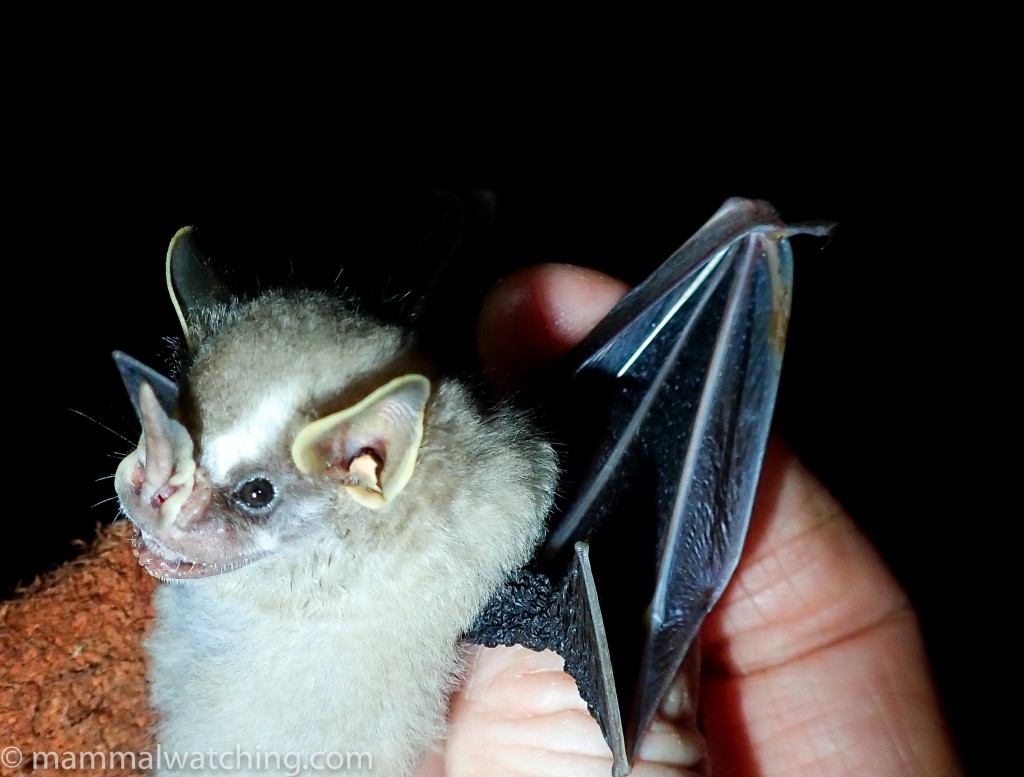
Pygmy Fruit-eating Bat (Artibeus phaeotis)
We spent both evenings batting. Fiona pulled out all the stops to try to catch some of the several bats on the Sylvan list that I hadn’t seen, most especially a Wrinkle-faced Bat. Although the batting was good – excellent by most standards – we didn’t get any of the species I was hoping for. I am pretty sure the full moon was partly to blame.
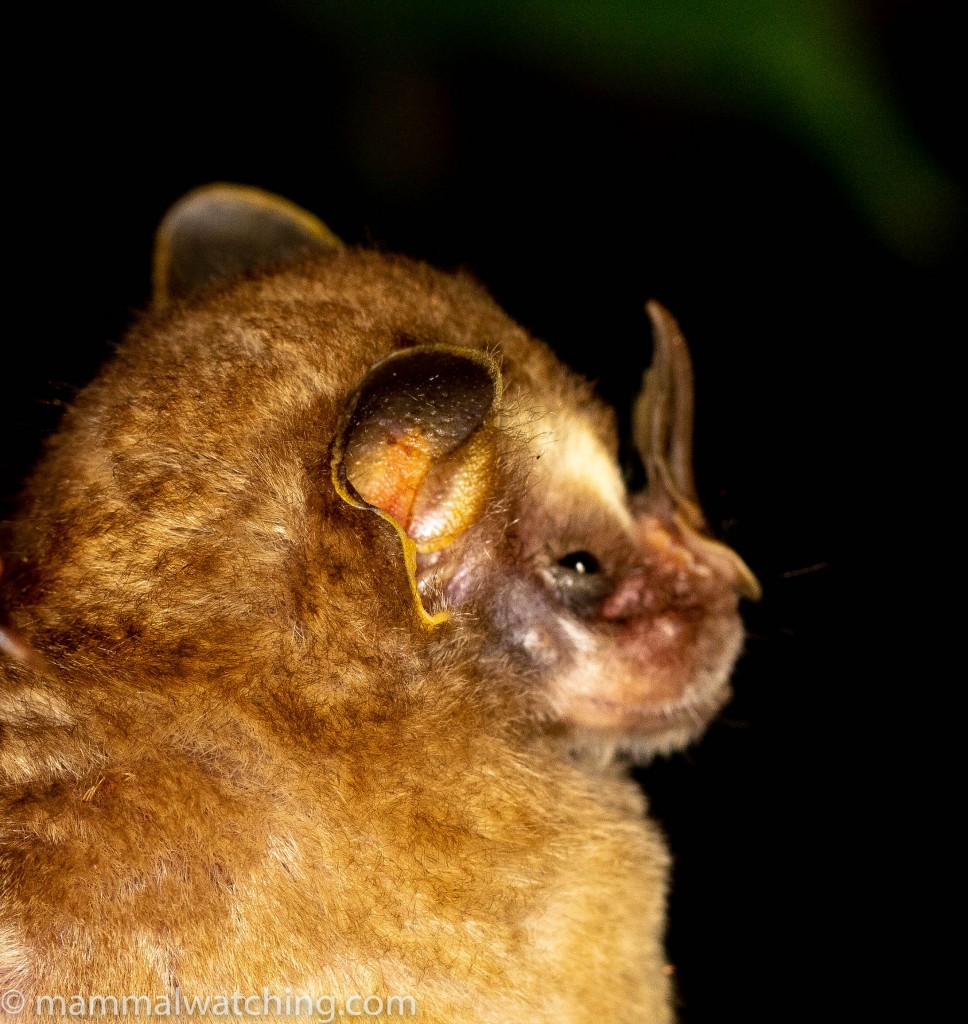
Pygmy Fruit-eating Bat (Artibeus phaeotis)
But we did catch a good diversity of bats. Commoner species included Merriam’s Long-tongued Bats; as well as Chestnut, Seba’s and Sowell’s Short-tailed Bats plus four species of Fruit-eating (Artibeus) bats: Jamaican, Great, Pygmy and Thomas’s.
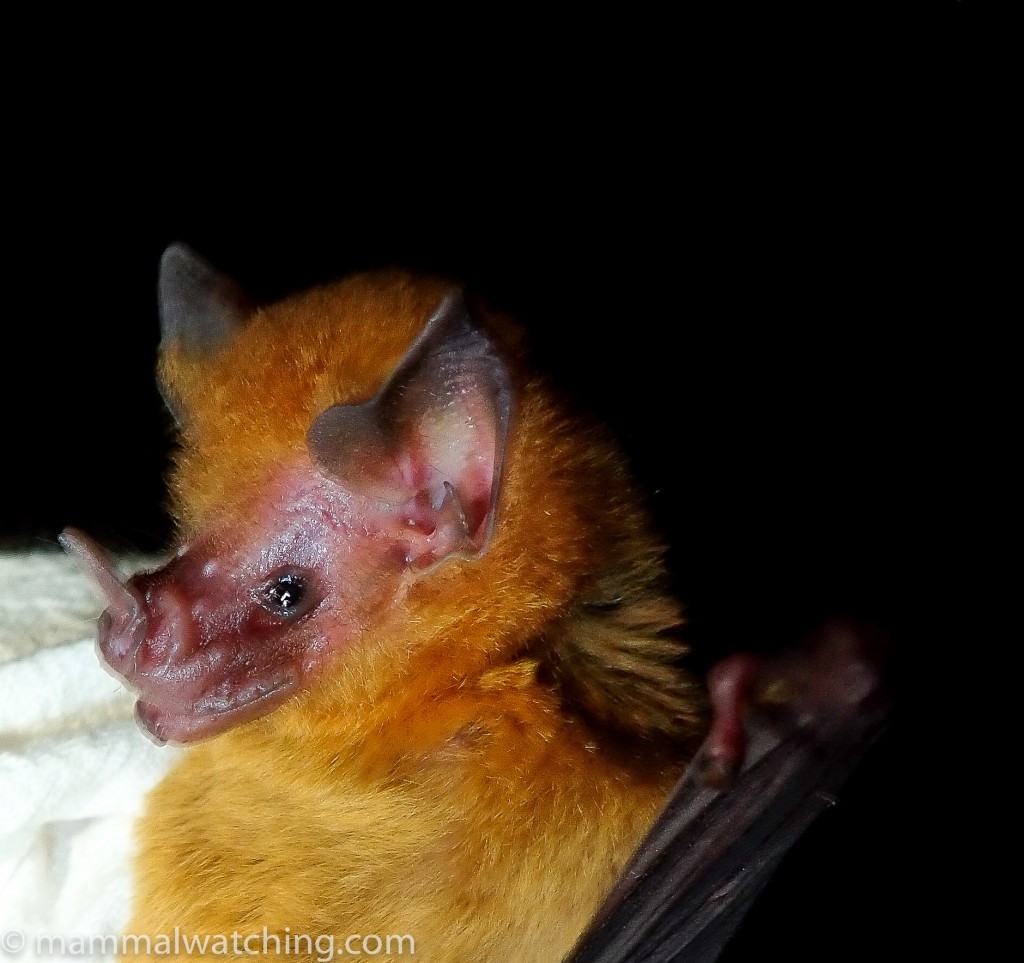
Orange-throated Bat (Lampronycteris brachyotis)
Rarer species included an Orange-throated Bat, which I had only seen once before in the Yucatan.
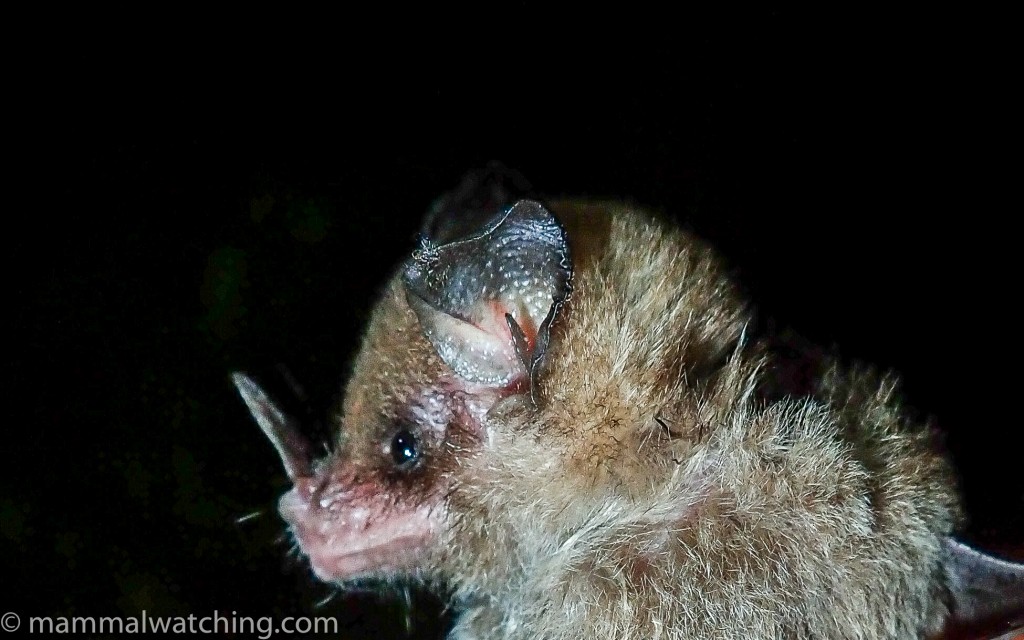
Niceforo’s Big-eared Bat (Trinycteris nicefori)
As well as my second Niceforo’s Bat , which I had seen once near Manaus.
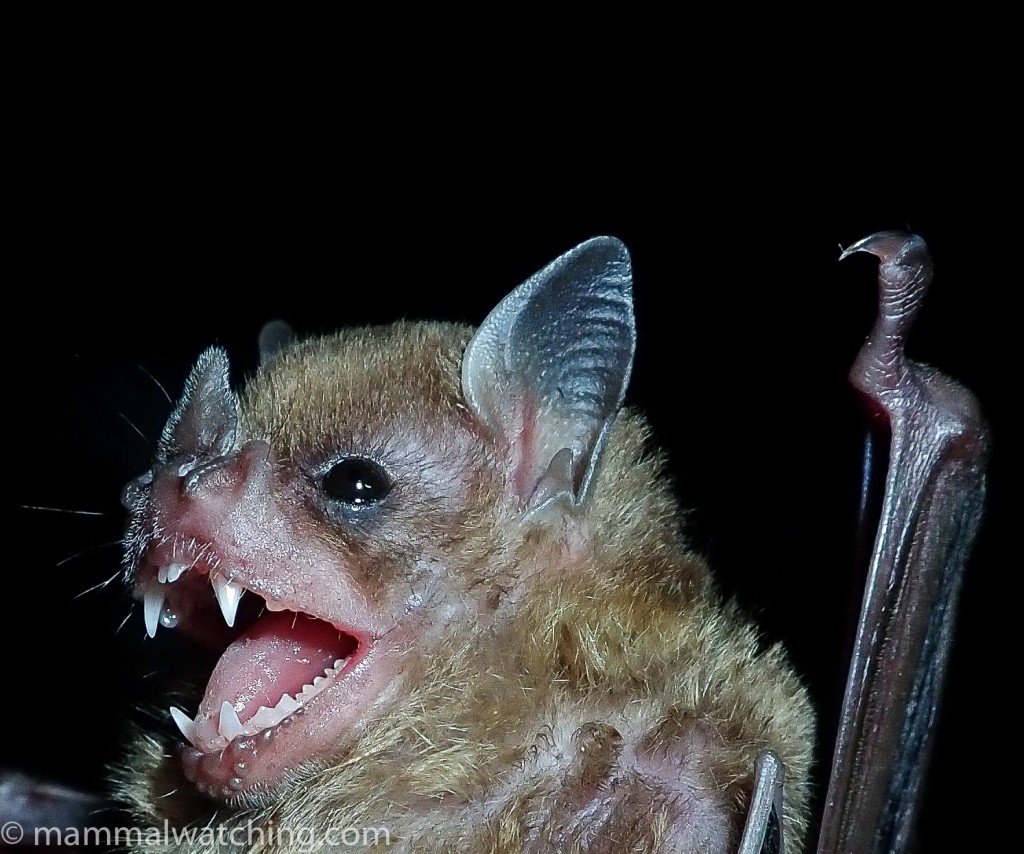
Northern Yellow-shouldered Bat (Sturnira parvidens)
We also caught a Hairy Big-eared Bat, Northern Yellow-shouldered Bat and a Northern Little Yellow-eared Bat.
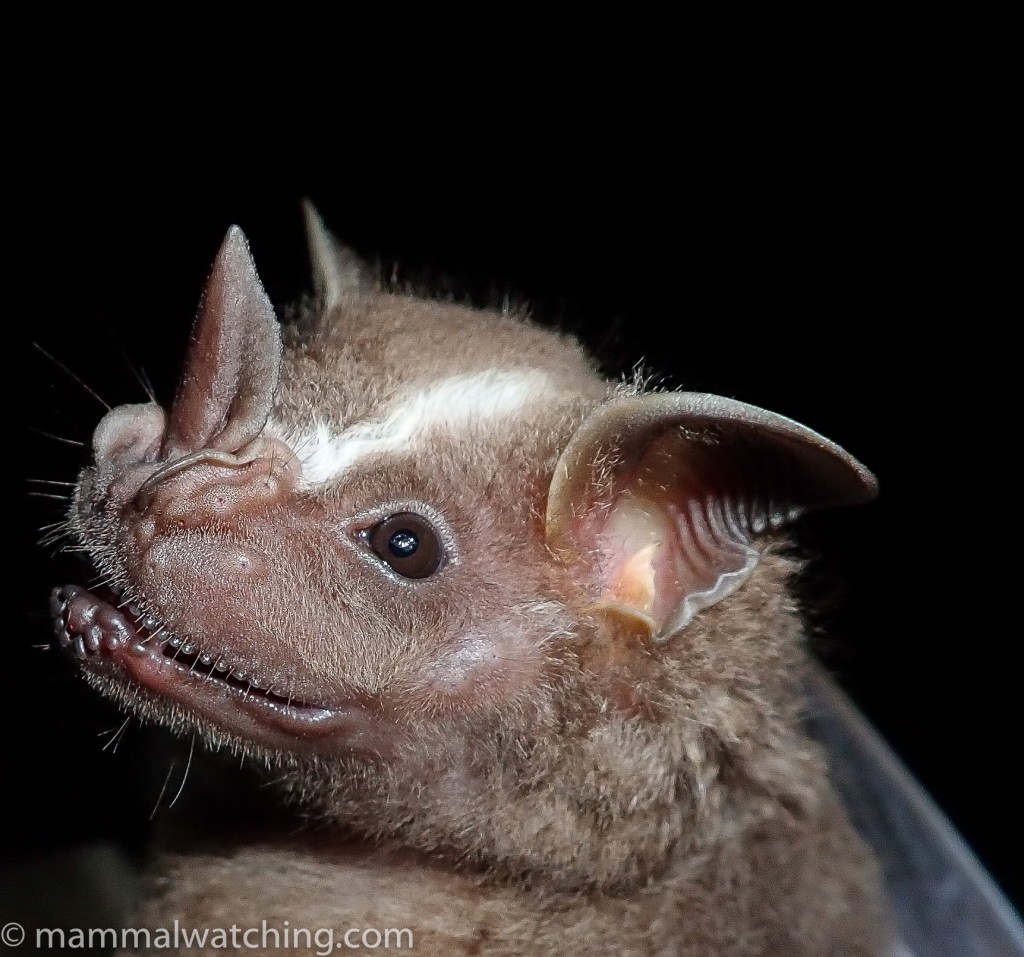
Great Fruit-eating Bat (Artibeus lituratus)
Other species – I am sure I forgot some – over the two nights included a Common Vampire Bat, some Mexican Black Myotis roosting under the roof and several impressive Greater Fishing (Bulldog) Bats netted over the river. At least 15 species over two nights was a pretty good haul even if I didn’t get the Wrinkle-faced Bat I was hoping for. Of course Fiona caught one the night I left. I was back in San Jose but was very tempted to delay my flight and drive back down, though that would have risked pushing my COVID test past its best before date to get into the USA. In retrospect I should of course have done just that: though I got out of Costa Rica the next day easily enough I got stuck in Florida for 3 nights trying to get back up to a snow-bound New York. I don’t know what I was thinking.
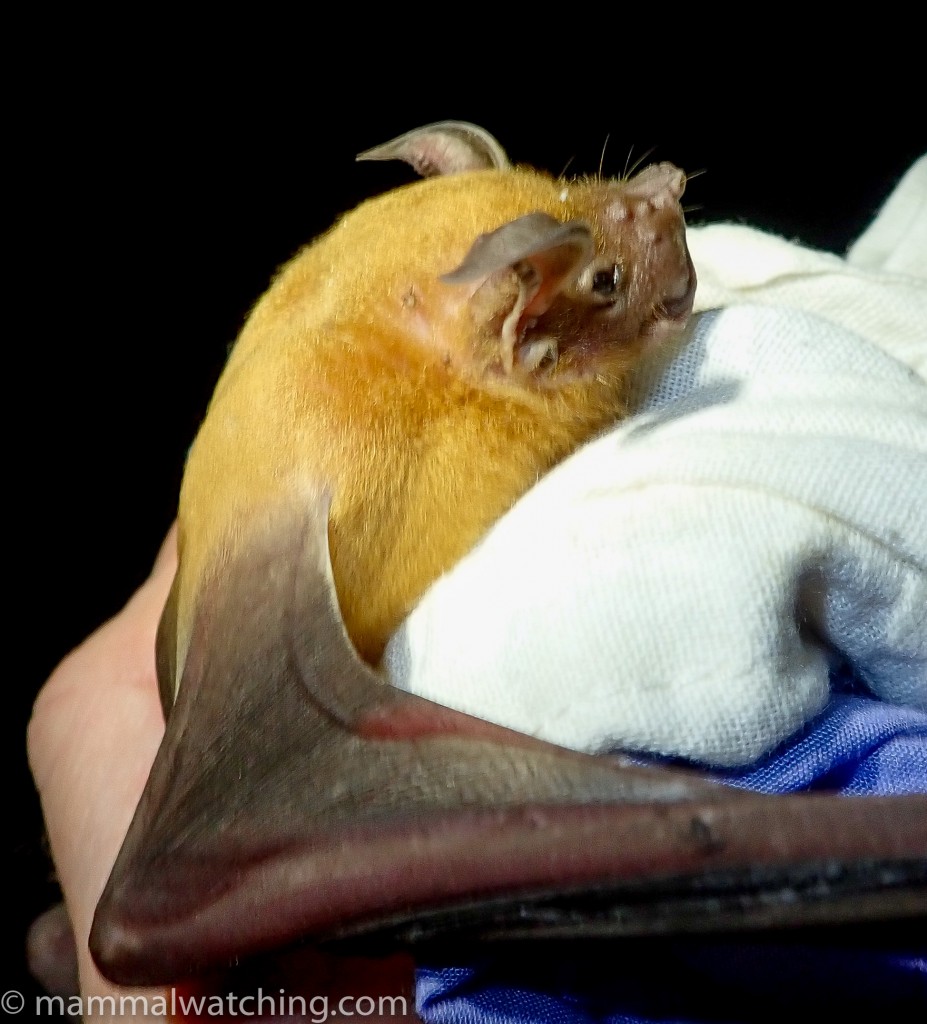
Lesser Bulldog Bat; Lesser Fishing Bat (Noctilio leporinus)
There is a lot more to see at Sylvan. Fiona’s lodge list is now up to a remarkable 53 bat species and over 80 mammals in total including Ocelot, Tayra, Tamandua, Neotropical River Otter and Central American Brocket Deer. I wasn’t looking for larger mammals but did come across some Central American Squirrel Monkeys on the walk into Sylvan.
Probably the best time to visit Sylvan is during one of the occasional Bat Blitzes that Fiona runs when a team of people will be using more nets than we could have managed.
Carara National Park
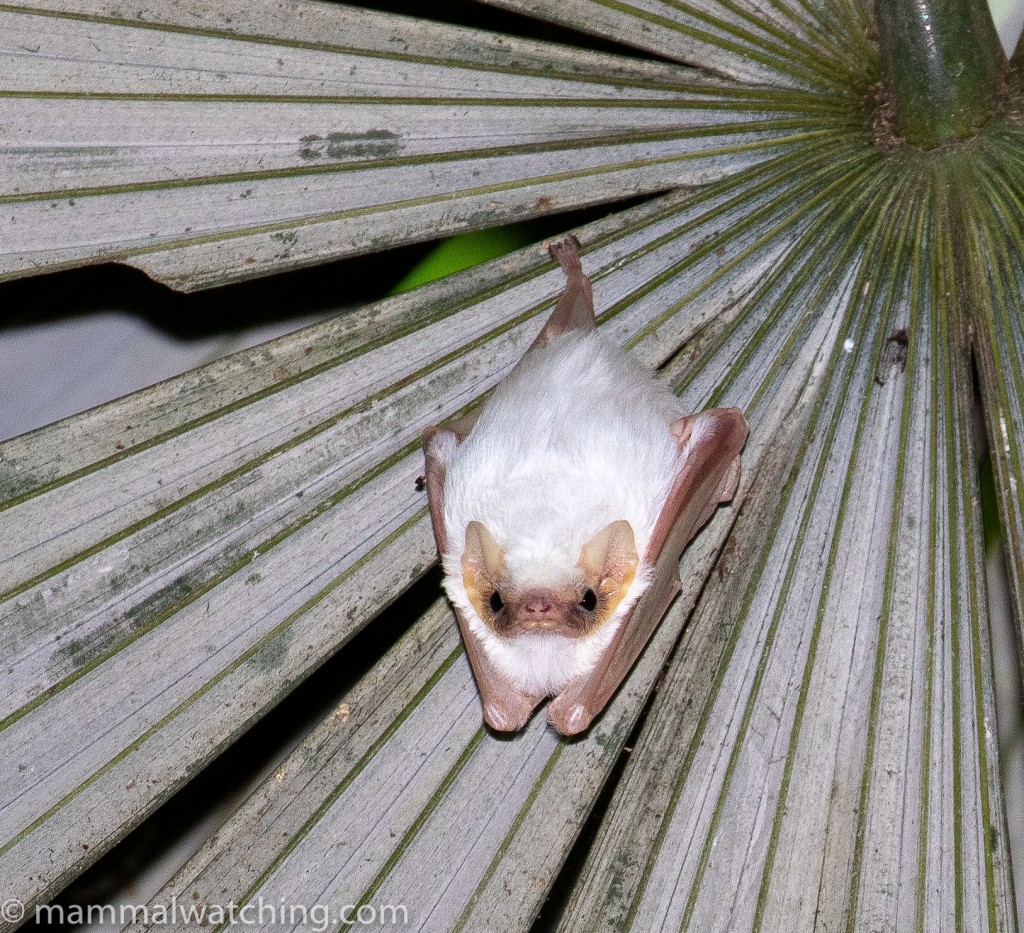
Northern Ghost Bat, Diclidurus albus
The road from Sylvan to San Jose takes you straight past Carara National Park, about 90 minutes from San Jose airport.
This is a reliable place to see the wonderful Northern Ghost Bats that have roosted under the same few Royal Palms in the park for many years. Though the bats move between palms the guides generally know where to find them. I contacted Carlos Roberto Chavarria beforehand to check the bats were there. He not only checked: he drove down from San Jose to meet me and make sure I saw them. Carlos is a guide and tour operator, who knows Costa Rica’s mammals very well. He seems like he would be a great guy to organize a specialized mammal tour around the country.
With the help of one of the park’s local guides it took only 30 minutes to see three bats roosting under a group of palms. A very cool species. Though they are easy to see in flight in some areas (e.g. over some rivers in the Amazon) they are much less easy to find roosting. So this was a definite highlight for me.
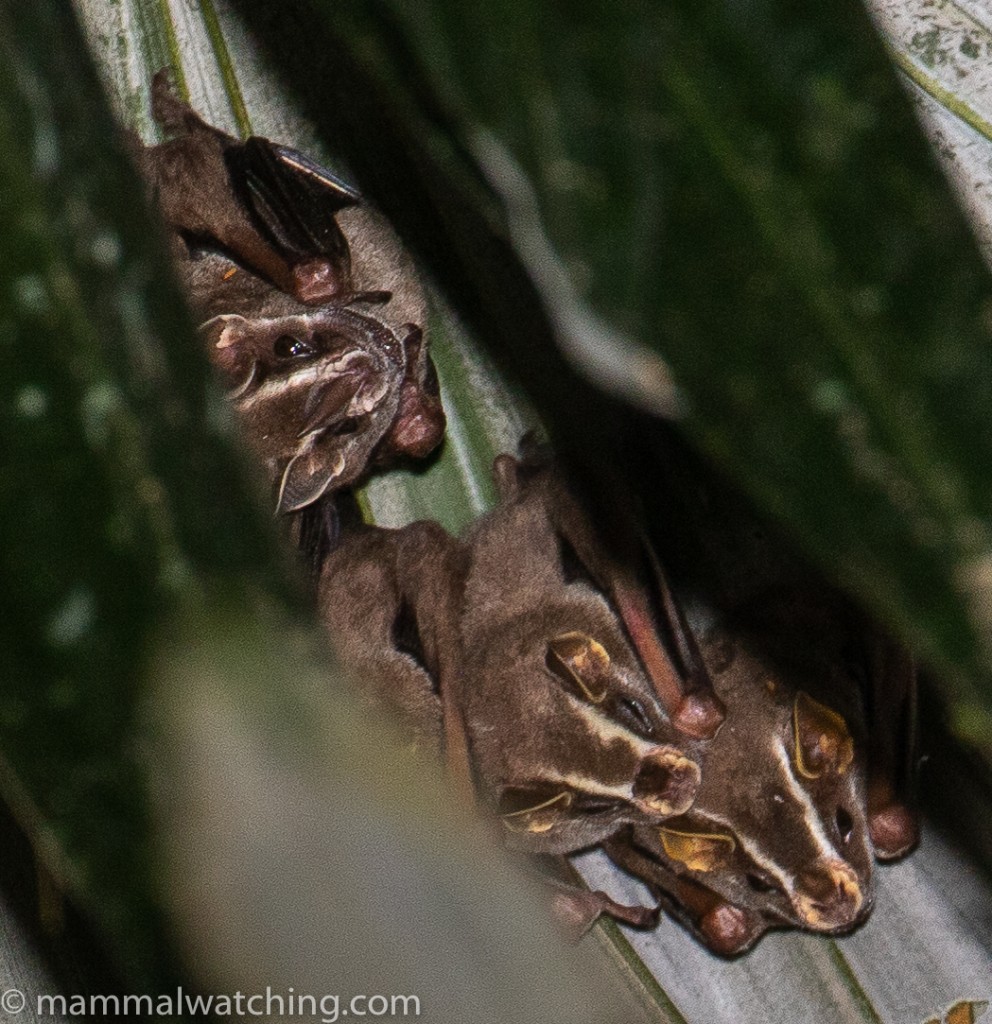
Pacific Tent-making Bat (Uroderma convexum)
Our guide showed us a few other roosting bats along the trails including a colony of Pacific Tent-making Bats (above) and Proboscis Bats (below).
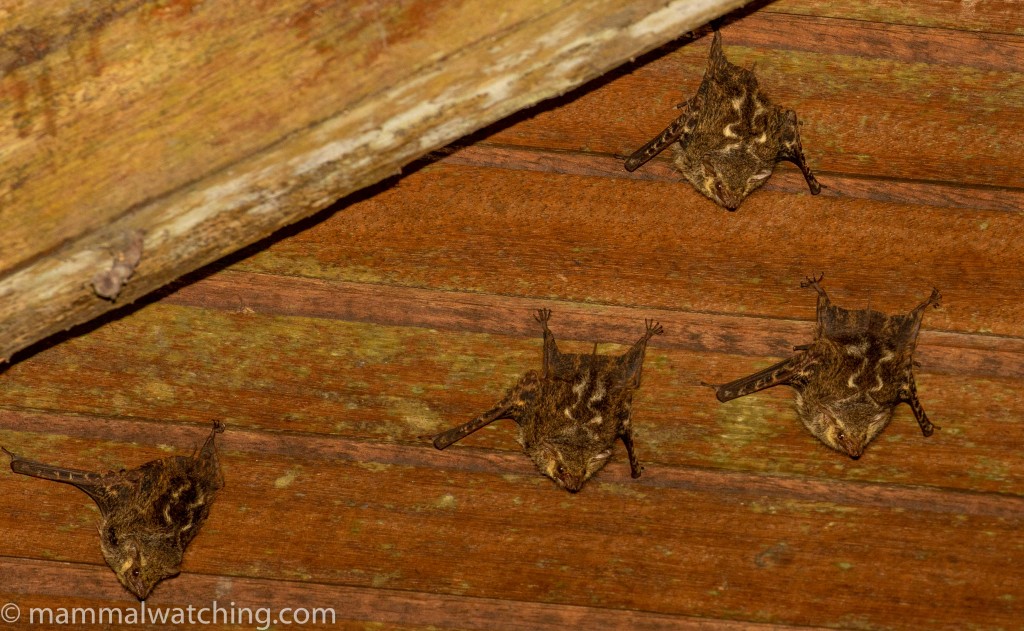
Proboscis Bats (Rhynchonycteris naso)
Thank You
Many many thanks to Jackie Willis for all her help with our Montane Squirrel search before we left, and to Selva Verde Lodge and Henry for keeping in touch – and caring – about their Thumbless Bats. Thanks also to Carlos Roberto Chavarria for his help at Carara and to the Seelye family for letting us enjoy their wonderful Las Vueltas. And of course thank you to Fiona for her company, expertise, and energetic, enthusiastic help to find me some new species.
Trip List
LEPORIDAE
F Dice’s Cottontail (Sylvilagus dicei)
HETEROMYIDAE
F Mountain Spiny Pocket Mouse (Heteromys oresturus)
DASYPROCTIDAE
Central American Agouti (Dasyprocta punctata)
SCIURIDAE
Red-tailed Squirrel (Sciurus granatensis)
Variegated Squirrel (S.variegatoides)
F Central American Dwarf Squirrel (Microsciurus alfari)
F Bangs’s Mountain Squirrel (Syntheosciurus brochus)
CRICETIDAE
F Chiriqui Harvest Mouse (Reithrodontomys creper
Nicaraguan Deermouse (Peromyscus nicaraguae)
F Talamancan Deermouse (Peromyscus nudipes)
Boquete Rice Rat (Nephelomys devius)
CEBIDAE
Black-crowned Central American Squirrel Monkey (Saimiri oerstedii)
EMBALLONURIDAE
Northern Ghost Bat (Diclidurus albus)
Proboscis Bat (Rhynchonycteris naso)
Greater Sac-winged Bat; Greater White-lined Bat (Saccopteryx bilineata)
Lesser Sac-winged Bat; Lesser White-lined Bat (S.leptura)
NOCTILIONIDAE
Greater Bulldog Bat; Greater Fishing Bat (Noctilio leporinus)
FURIPTERIDAE
F Thumbless Bat (Furipterus horrens)
PHYLLOSTOMIDAE
Orange-throated Bat (Lampronycteris brachyotis)
Hairy Big-eared Bat (Micronycteris hirsuta)
Common Big-eared Bat (M.microtis)
Common Vampire Bat (Desmodus rotundus)
Merriam’s Long-tongued Bat (Glossophaga mutica)
Chestnut Short-tailed Bat (Carollia castanea)
Seba’s Short-tailed Bat (C.perspicillata)
Sowell’s Short-tailed Bat (C.sowelli)
Niceforo’s Big-eared Bat (Trinycteris nicefori)
Northern Yellow-shouldered Bat (Sturnira parvidens)
Pacific Tent-making Bat (Uroderma convexum)
Northern Little Yellow-eared Bat (Vampyressa thyone)
Jamaican Fruit-eating Bat (Artibeus jamaicensis)
Great Fruit-eating Bat (A.lituratus)
Pygmy Fruit-eating Bat (A.phaeotis)
Thomas’s Fruit-eating Bat (A.watsoni)
VESPERTILIONIDAE
Desert Red Bat (Lasiurus frantzii)
Mexican Black Myotis (Myotis extremus)
PROCYONIDAE
White-nosed Coati (Nasua narica)
3y species and 7 lifers (F)
9 Comments
-
mikehoit
Great report Jon – always love these ones targetting rats & bats…Sounds like it might make more sense to search for
the montane squirrel when I’m at Cerro de la Muerte rather than relying on Poas then.
Do you get the impression it would be possible to see the thumbless bats without staying at Selva Verde? We’re booked to stay at both La Selva & Tirimbina in that area, bur wonder if they’d take visitors willing to make a donation/have lunch at the lodge.cheers
Mike -
-
Manul
Congratulations on the Montane Squirrel and the Dice’s Cottontail! Very exciting for us to hear that we have probably really seen a Montane Squirrel!
Sorry to hear about your adventure on the road though. We managed with a Suzuki Jimny and thought it would be fine with pretty much any other car…
Sophie
Leave a Reply
You must be logged in to post a comment.


Jim Tassano
Great job. Thanks!